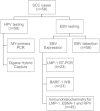Human papillomavirus and Epstein-Barr virus co-infection in cervical carcinoma in Algerian women
- PMID: 24252325
- PMCID: PMC4225508
- DOI: 10.1186/1743-422X-10-340
Human papillomavirus and Epstein-Barr virus co-infection in cervical carcinoma in Algerian women
Abstract
Background: Despite the fact that the implication of human papillomavirus (HPV) in the carcinogenesis and prognosis of cervical cancer is well established, the impact of a co-infection with high risk HPV (HR-HPV) and Epstein-Barr virus (EBV) is still not fully understood.
Methods: Fifty eight randomly selected cases of squamous cell carcinomas (SCC) of the uterine cervix, 14 normal cervices specimens, 21 CIN-2/3 and 16 CIN-1 cases were examined for EBV and HPV infections. Detection of HR-HPV specific sequences was carried out by PCR amplification using consensus primers of Manos and by Digene Hybrid Capture. The presence of EBV was revealed by amplifying a 660 bp specific EBV sequence of BALF1. mRNA expression of LMP-1 in one hand and protein levels of BARF-1, LMP-1 and EBNA-1 in the other hand were assessed by RT-PCR and immunoblotting and/or immunohischemistry respectively.
Results: HR-HPV infection was found in patients with SCC (88%), low-grade (75%) and high grade (95%) lesions compared to only 14% of normal cervix cases. However, 69%, 12.5%, 38.1%, and 14% of SCC, CIN-1, CIN-2/3 and normal cervix tissues, respectively, were EBV infected. The highest co-infection (HR-HPV and EBV) was found in squamous cell carcinoma cases (67%). The latter cases showed 27% and 29% expression of EBV BARF-1 and LMP-1 oncogenes respectively.
Conclusion: The high rate of HR-HPV and EBV co-infection in SCC suggests that EBV infection is incriminated in cervical cancer progression. This could be taken into account as bad prognosis in this type of cancer. However, the mode of action in dual infection in cervical oncogenesis needs further investigation.
Figures






Similar articles
-
Epstein-Barr virus, but not human cytomegalovirus, is associated with a high-grade human papillomavirus-associated cervical lesions among women in North Carolina.J Med Virol. 2019 Mar;91(3):450-456. doi: 10.1002/jmv.25336. Epub 2018 Oct 31. J Med Virol. 2019. PMID: 30307626 Free PMC article.
-
Epstein-Barr virus (EBV) genes expression in cervical intraepithelial neoplasia and invasive cervical cancer: a comparative study with human papillomavirus (HPV) infection.Hum Pathol. 2000 Mar;31(3):318-26. doi: 10.1016/s0046-8177(00)80245-2. Hum Pathol. 2000. PMID: 10746674
-
Possible contributing role of Epstein-Barr virus (EBV) as a cofactor in human papillomavirus (HPV)-associated cervical carcinogenesis.J Clin Virol. 2015 Dec;73:70-76. doi: 10.1016/j.jcv.2015.10.015. Epub 2015 Oct 23. J Clin Virol. 2015. PMID: 26551071
-
Association between Epstein-Barr virus (EBV) and cervical carcinoma: A meta-analysis.Gynecol Oncol. 2018 Feb;148(2):317-328. doi: 10.1016/j.ygyno.2017.10.005. Epub 2017 Oct 9. Gynecol Oncol. 2018. PMID: 29021084 Review.
-
Evidence of human papilloma virus infection but lack of Epstein-Barr virus in lymphoepithelioma-like carcinoma of uterine cervix: report of two cases and review of the literature.Hum Pathol. 2001 Jan;32(1):135-8. doi: 10.1053/hupa.2001.20901. Hum Pathol. 2001. PMID: 11172309 Review.
Cited by
-
Role of Epstein-Barr Virus and Human Papillomavirus Coinfection in Cervical Cancer: Epidemiology, Mechanisms and Perspectives.Pathogens. 2020 Aug 21;9(9):685. doi: 10.3390/pathogens9090685. Pathogens. 2020. PMID: 32839399 Free PMC article. Review.
-
Prevalence of Human Papillomavirus and Co-Infection with Epstein-Barr Virus in Oral and Oropharyngeal Squamous Cell Carcinomas.Asian Pac J Cancer Prev. 2022 Nov 1;23(11):3931-3937. doi: 10.31557/APJCP.2022.23.11.3931. Asian Pac J Cancer Prev. 2022. PMID: 36444607 Free PMC article.
-
Co-infection of Epstein-Barr virus and human papillomavirus in human tumorigenesis.Chin J Cancer. 2016 Jan 22;35:16. doi: 10.1186/s40880-016-0079-1. Chin J Cancer. 2016. PMID: 26801987 Free PMC article. Review.
-
Role of Epstein-Barr Virus and Human Papillomavirus Coinfection in Cervical Intraepithelial Neoplasia in Chinese Women Living With HIV.Front Cell Infect Microbiol. 2021 Sep 7;11:703259. doi: 10.3389/fcimb.2021.703259. eCollection 2021. Front Cell Infect Microbiol. 2021. PMID: 34557425 Free PMC article.
-
Interplay between Epstein-Barr virus infection and environmental xenobiotic exposure in cancer.Infect Agent Cancer. 2021 Jun 30;16(1):50. doi: 10.1186/s13027-021-00391-2. Infect Agent Cancer. 2021. PMID: 34193233 Free PMC article. Review.
References
-
- Anderson L, O’Rorke M, Jamison J, Wilson R, Gavin A. HPV Working Group members. Prevalence of human papillomavirus in women attending cervical screening in the UK and Ireland: new data from Northern Ireland and a systematic review and meta-analysis. J Med Virol. 2013;85:295–308. doi: 10.1002/jmv.23459. - DOI - PubMed
-
- Nichols W, Sutton K, Nelson N, Clark A, Oddo H, Love N, Hagensee M. (Abstract) 27th International Papillomavirus Conference, Clinical Workshop. Berlin, Germany; 2011. Epstein-Barr virus as a Potential Biomarker for Cervical Dysplasia; pp. 14–15. (Abstract book 2, page 59). http://www.hpv2011.org/index1.asp?siteid=1&pageid=63.
-
- Ekalaksananan T, Aromseree S, Pientong C, Sunthamala N, Swangphon P, Chaiwongkot A, Kongyingyoes B, Patarapadungkit N, Chumworathayee B. 27th International Papillomavirus Conference and Clinical Workshop. Berlin, Germany; 2011. (Abstract), Co-infection of Epstein-Barr Virus (EBV) with High Risk Human Papillomavirus (HR-HPV) is a Significant Risk of Cervical Cancer; pp. 14–33. (Abstract book 2, page 68). http://www.hpv2011.org/index1.asp?siteid=1&pageid=63.
-
- Silver MI, Paul P, Sowjanya P, Ramakrishna G, Vedantham H, Kalpana B, Shah KV, Gravitt PE. Shedding of Epstein-Barr virus and cytomegalovirus from the genital tract of women in a periurban community in Andhra Pradesh, India. J Clin Microbiol. 2011;49:2435–2439. doi: 10.1128/JCM.02206-10. - DOI - PMC - PubMed
Publication types
MeSH terms
Substances
LinkOut - more resources
Full Text Sources
Other Literature Sources
Medical
Research Materials

